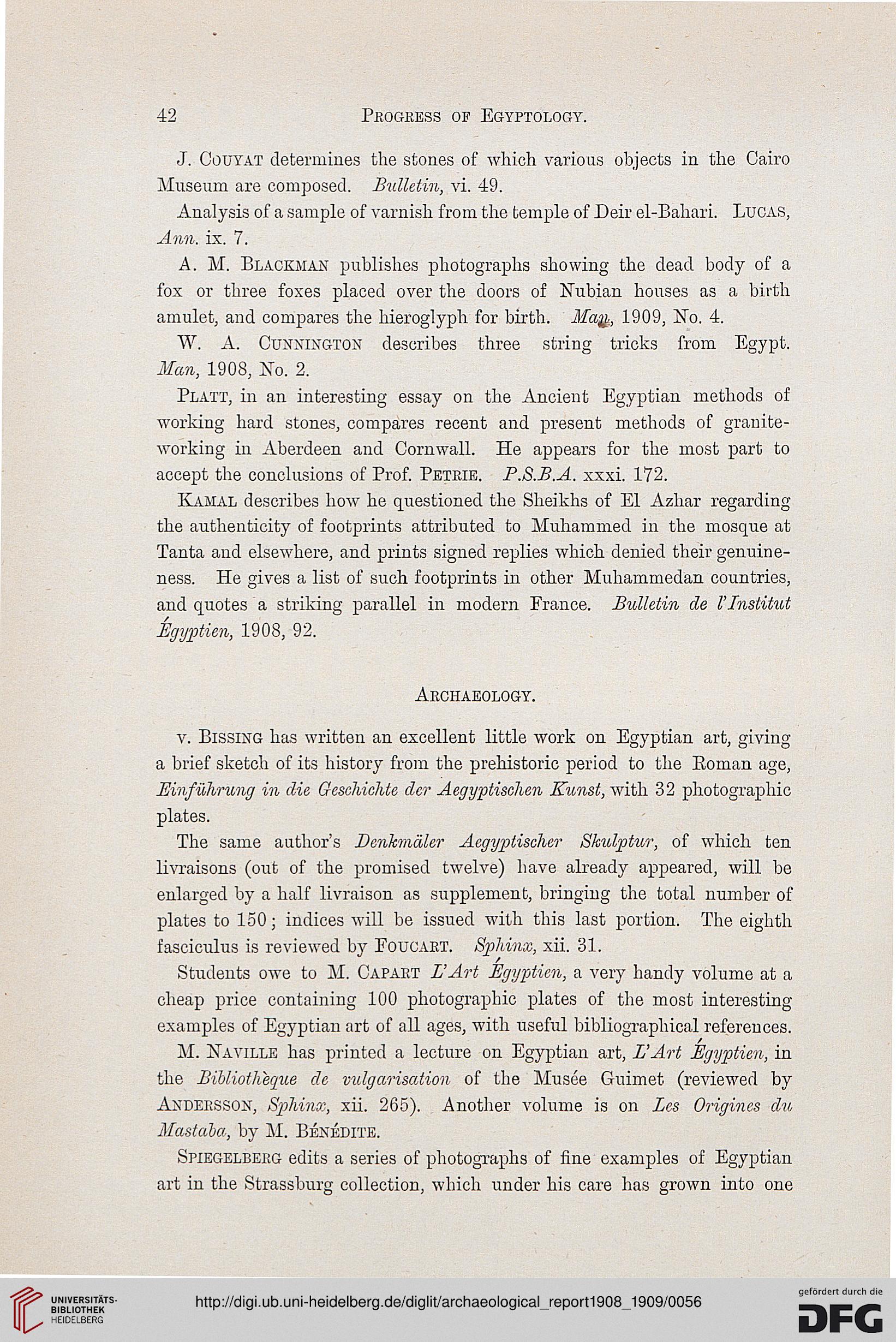42
Progress of Egyptology.
J. Couyat determines the stones of which various objects in the Cairo
Museum are composed. Bulletin, vi. 49.
Analysis of a sample of varnish from the temple of Deir el-Bahari. Lucas,
Ann. ix. 7.
A. M. Blackman publishes photographs showing the dead body of a
fox or three foxes placed over the doors of Nubian houses as a birth
amulet, and compares the hieroglyph for birth. Ma%, 1909, ISTo. 4.
W. A. CUNNINGTON describes three string tricks from Egypt.
Man, 1908, No. 2.
PlATT, in an interesting essay on the Ancient Egyptian methods of
working hard stones, compares recent and present methods of granite-
working in Aberdeen and Cornwall. He appears for the most part to
accept the conclusions of Prof. Peteie. P.S.B.A. xxxi. 172.
Kamal describes how he questioned the Sheikhs of El Azhar regarding
the authenticity of footprints attributed to Muhammed in the mosque at
Tanta and elsewhere, and prints signed replies which denied their genuine-
ness. He gives a list of such footprints in other Muhammedan countries,
and quotes a striking parallel in modern France. Bulletin de I'Institut
Egyptian, 1908, 92.
Archaeology.
v. Bissing has written an excellent little work on Egyptian art, giving
a brief sketch of its history from the prehistoric period to the Boman age,
Einfuhhmg in die Geschichte dcr Aegyptischen Kunst, with 32 photographic
plates.
The same author's Dcnkmdlcr Acgyptischer Skulptur, of which ten
livraisons (out of the promised twelve) have already appeared, will be
enlarged by a half livraison as supplement, bringing the total number of
plates to 150; indices will be issued with this last portion. The eighth
fasciculus is reviewed by EouoAET. Sphinx, xii. 31.
Students owe to M. Capaet L'Art EgypAien, a very handy volume at a
cheap price containing 100 photographic plates of the most interesting-
examples of Egyptian art of all ages, with useful bibliographical references.
M. jSTaville has printed a lecture on Egyptian art, L'Art Egyptien, in
the Bibliotheque de vulgarisation of the Musee Guimet (reviewed by
Axdeesson, Sphinx, xii. 265). Another volume is on Les Origines du
Mastaba, by M. Benedite.
Spiegelbeeg edits a series of photographs of fine examples of Egyptian
art in the Strassburg collection, which under his care has grown into one
Progress of Egyptology.
J. Couyat determines the stones of which various objects in the Cairo
Museum are composed. Bulletin, vi. 49.
Analysis of a sample of varnish from the temple of Deir el-Bahari. Lucas,
Ann. ix. 7.
A. M. Blackman publishes photographs showing the dead body of a
fox or three foxes placed over the doors of Nubian houses as a birth
amulet, and compares the hieroglyph for birth. Ma%, 1909, ISTo. 4.
W. A. CUNNINGTON describes three string tricks from Egypt.
Man, 1908, No. 2.
PlATT, in an interesting essay on the Ancient Egyptian methods of
working hard stones, compares recent and present methods of granite-
working in Aberdeen and Cornwall. He appears for the most part to
accept the conclusions of Prof. Peteie. P.S.B.A. xxxi. 172.
Kamal describes how he questioned the Sheikhs of El Azhar regarding
the authenticity of footprints attributed to Muhammed in the mosque at
Tanta and elsewhere, and prints signed replies which denied their genuine-
ness. He gives a list of such footprints in other Muhammedan countries,
and quotes a striking parallel in modern France. Bulletin de I'Institut
Egyptian, 1908, 92.
Archaeology.
v. Bissing has written an excellent little work on Egyptian art, giving
a brief sketch of its history from the prehistoric period to the Boman age,
Einfuhhmg in die Geschichte dcr Aegyptischen Kunst, with 32 photographic
plates.
The same author's Dcnkmdlcr Acgyptischer Skulptur, of which ten
livraisons (out of the promised twelve) have already appeared, will be
enlarged by a half livraison as supplement, bringing the total number of
plates to 150; indices will be issued with this last portion. The eighth
fasciculus is reviewed by EouoAET. Sphinx, xii. 31.
Students owe to M. Capaet L'Art EgypAien, a very handy volume at a
cheap price containing 100 photographic plates of the most interesting-
examples of Egyptian art of all ages, with useful bibliographical references.
M. jSTaville has printed a lecture on Egyptian art, L'Art Egyptien, in
the Bibliotheque de vulgarisation of the Musee Guimet (reviewed by
Axdeesson, Sphinx, xii. 265). Another volume is on Les Origines du
Mastaba, by M. Benedite.
Spiegelbeeg edits a series of photographs of fine examples of Egyptian
art in the Strassburg collection, which under his care has grown into one




